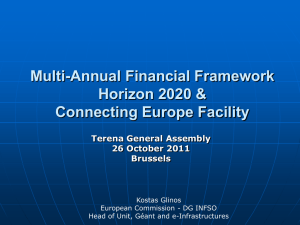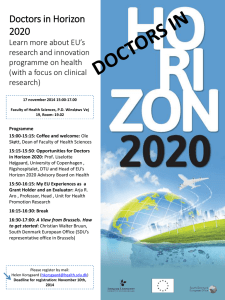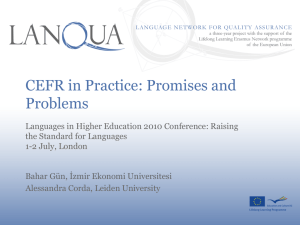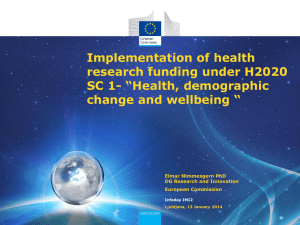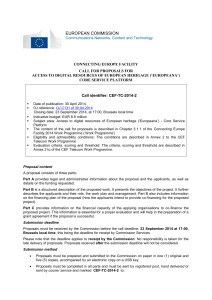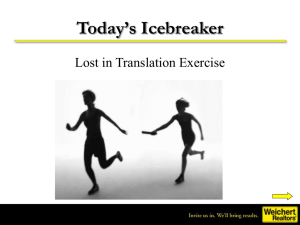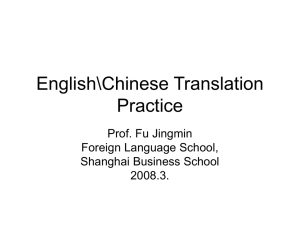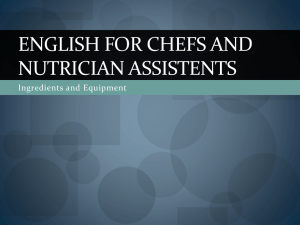open data
advertisement
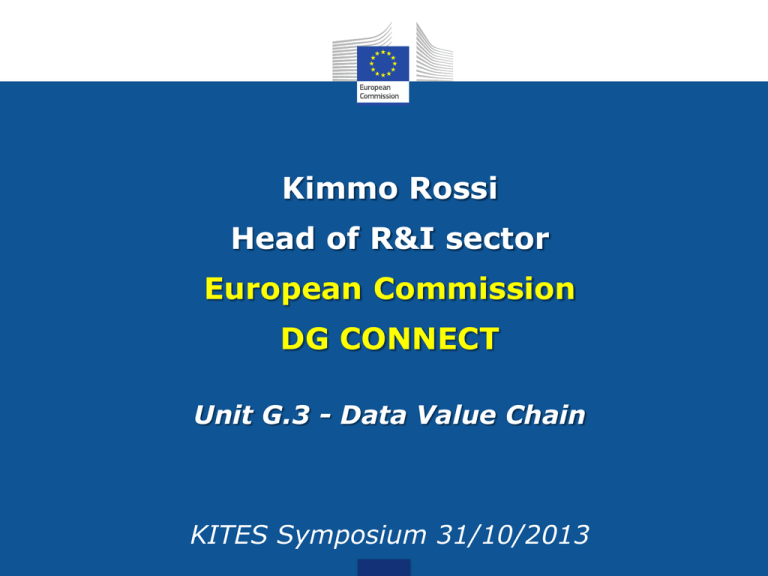
Kimmo Rossi Head of R&I sector European Commission DG CONNECT Unit G.3 - Data Value Chain KITES Symposium 31/10/2013 EUROPEAN COMMISSION The Communication Networks, Content & Technology Directorate General (DG CONNECT) Directorate G - Media and Data G1: Converging Media and Content G2: Creativity G3: Data Value Chain G4: Inclusion, Skills and Youth G5: Administration and Finance 2 Who are we? Unit CNECT.G3 – Data Value Chain Resulted from merging three units in July 2012: • Language technologies (language data, analytics) • Information management (big data, linked data, analytics) • Public sector information (open data) We manage a portfolio of 130 R&I projects with 300+ MEUR EU funding, 1500 FTE Responsible for: European Data value chain strategy, open data strategy and the PSI directive Definitions What is Open Data? A useful definition: http://opendefinition.org/ • free of charge (or almost) • free to use, re-use, distribute • ...for any purpose (also commercially) • can be public OD (government) or private OD (usergenerated, corporate) • must not violate privacy • www.open-data.europa.eu (EU OD portal) • http://publicdata.eu (the LOD2 project) Definitions What is Linked Data? Linking Open Data cloud diagram, by Richard Cyganiak and Anja Jentzsch. http://lod-cloud.net/ Definitions What is Linked Data? Allows access to Web content as a database – very useful! But there are problems: • What merits to be linked? • How to establish links? • How to ensure quality of (automatically established) links? • Currently very scarce and English-dominated For details, see LOD2 project: http://lod2.eu Definitions What is Big Data? Very difficult to define... • data is "big" if it defies traditional processing & storage paradigms – bigness becomes part of the problem • the "3Vs": volume (size), velocity (bytes/s), variety (database, jpeg, video, numbers, text in language X...) • ...to which we add the 4th V to denote creation of Value (by linking, aggregating, analysing, visualizing...) • "linguistic" big data: all tweets, all news broadcasts, YouTube contents... • statistical MT is powered (trained) by big data – but can it handle big data? European Data value chain strategy Objective: to put in place the "systemic" prerequisites for effective use, exchange, re-use, trading... of data assets • capacities and skills: build and multiply the "new" competences, curricula, prize/recognition schemes • infrastructures: Open Data Portal, language resource infrastructure, evaluation platforms, incubators • legal and regulatory framework: PSI directive (Public Open Data), data protection and privacy, copyright • technology, tools, methods: supporting the above • pilots, demonstrators: demonstrating the above in realworld problem settings, market validation Instruments Making it happen Research and innovation: Horizon 2020 – the Research & Innovation funding programme for 2014-2020 • Big Data analytics, prediction, MT: cross-language and cross-sectoral (industrial) validation, capacity-building Deployment and service infrastructures: Connecting Europe Facility (CEF), addressing, for example: • Open Data Portal, Automated translation, language resources & tools repository Policy and regulation: PSI directive, privacy, copyright • Support creation of Data market, remove obstacles from re-use of valuable data Projects Some ongoing and emerging initiatives • META-SHARE: language resources repository and sharing infrastructure www.meta-share.eu • MT training and deployment pilots: MT@EC, iTranslate4.eu, LetsMT!, Bologna... • MosesCore: making most out of MOSES www.mosescore.eu • MultilingualWeb: standards and workflows for language processing www.multilingualweb.eu • FALCON: Linked (Open) Data for localisation, MT and term extraction, LIDER: Linked Data as enabler of cross-media and multilingual content analytics • LT Innovate: networking the language industry www.lt-innovate.eu MT@EC MT@EC • The internal Machine Translation project of Commission's DG Translation • Aim: to provide functional MT service for EU institutions and (later), MS administrations, pan-EU online services • Currently based on MOSES open source technology (but open to other solutions as plug-in) • In pilot use since summer 2011 (EC) • In production since June 2013 (EU institutions) • Already 8 million pages translated • Very good quality for some language pairs Coming up 2014-2020 On the next slides, I will present topics of interest from the current state of: • Horizon 2020 • Connecting Europe Facility Disclaimer: the programmes described in the next slides are at the level of proposal/draft and subject to change following a multi-party adoption process. Only the versions formally adopted by the legislative bodies can be considered final and binding. 12 Connecting Europe Facility (CEF) 13 CEF – Overview What is CEF? • A funding programme for infrastructures and deployment of digital services • procurement and deployment of mature technology to build a "core platform" • grants for "generic services" building on and linking to core platform • Includes a small number of "building blocks" (e.g. document delivery, eInvoicing, eID, Automated translation) What CEF is not? • research or innovation (Horizon 2020 is for that) How much? • 1 B€ in total for the "Telecommunications" title (Broadband & Digital services) 14 CEF – Automated Translation (AT) Rationale • Automated Translation (AT) is a "building block" • AT will serve the other Digital Services Infrastructures in CEF • AT = whatever it takes to make DSIs actually multilingual Features • Adaptable machine translation and relevant Language Resources are central • Other likely key areas: CAT, CMS, terminology, semantic interoperability, interfaces to various systems and data types • Human element is essential: service provision, quality control, validation, post-editing, on-demand response... Instruments: mostly procurement (calls for tender) National dimension: CEF implies and encourages partnerships with member states and regions, e.g. use of structural funds for language resources and, technology and translation on a "local" basis 15 CEF – stakeholders, contributors Language industry • providers of language technology, especially MT • language service providers Language competence centres: provision of language resources, tools, validation and evaluation Member states/regions: coordinating local/national/regional programs and initiatives with CEF to reach critical mass 16 Horizon 2020 – the Research and Innovation programme 17 H2020 Work Programme 2014-15 DRAFT! Some topics: • Big Data & Open data - Innovation – 50 M€ • Big Data – Research – 39 M€ • Cracking the language barrier – 15 M€ • Multimodal & natural interaction – 7.5 M€ 18 Big Data - Rationale DRAFT! (Big/Smart/Open) Data represents significant potential for job creation and wealth (revenue) generation European Data landscape is fragmented • data producers: public sector, private sector, sensors, devices, transactions... • data industry: a few large companies, high number of SMEs • language barriers, legal & institutional obstacles • data users: practically all industry sectors We need to create European Data ecosystem, where • data flows without unnecessary obstacles (open data, interoperability) • data creates value (by analysing, linking, visualizing...) • data and the added value is accessible to all actors • we have appropriate capacities for value creation (skills, infrastructures, markets, technology) 19 Big Data – How DRAFT! Improve EU capacities, develop generic technology and address entire data value chains and markets - cross-sector, crossborder, cross-language 1. Innovation actions: promote open data value chains and data markets, involve SMEs, technology transfer and data exchange/reuse in cross-sector/cross-border settings, network of European skills centres for big data analytics technologies and business development 2. Research actions: novel data structures, algorithms, architectures, optimization and language understanding technologies etc. for analysis and visualisation tasks on extremely large and diverse data streams; competitions/prize schemes around specific big data challenges (e.g. prediction, deep analysis) arising from key industrial domains (e.g. geo-spatial, energy, finance, health, skills/employment, agriculture, climate/weather, product recommendations...) Implies: strong attention to application areas: building the (sub)communities and links to sector-specific Societal Challenges 20 Big Data – What DRAFT! Innovation (50 M€, Call 1) 1. Open Data reuse incubator for SMEs: spin off mini projects building experiments and proofs-of-concept for business models and value-adding chains based on reuse of Open Data. 2. Collaborative projects on cross-sectoral, cross-border, crosslingual analytics solutions/services, technology transfer, market validation, clear business cases. 3. Horizontal actions: • Cross-program coordination on Big Data • Network of skills centres, curricula, training and education • Networking, clustering, legal issues etc. Research (39 M€, Call 2) 1. Collaborative projects addressing analysis, prediction, visualization on extremely large, diverse (multilingual, structured/unstructured) data 2. Collaborative projects to set up benchmarking and evaluation settings for big data analysis and prediction 3. Prize schemes to stimulate excellence in deep analysis and prediction on Big Data 21 Cracking the language barrier DRAFT! Problem: European Digital Single Market is fragmented by language barriers. Current (e.g. Google) machine translation solutions fall short in quality and coverage (languages, text types, topics) and are not customizable. Lack of cross-lingual technology equally hampers progress in multi- and cross-lingual analytics Solution: explore new avenues, methods, approaches to achieve significant improvement in translation quality in fully automatic MT. Special emphasis on: all (difficult, small) EU languages as target language. Self-learning/self-improving systems, making best use of available data and language resources. Special focus on the EU languages "facing digital extinction". Implications: close collaboration and clustering with other actions supporting language resources infrastructure (META, Connecting Europe Facility, national programs, structural funds) 22 Cracking the language barrier – How DRAFT! Approach: explore new avenues, methods, approaches to achieve significant improvement in translation quality in MT. Self-learning/self-improving autonomous, fully automatic systems, making best use of available data and language resources. Emphasis on: all (difficult, small) EU languages as target language. Special focus on the EU languages "facing digital extinction". Implications: close collaboration and clustering among all actions supporting a language infrastructure (META, CLARIN-ERIC, Connecting Europe Facility, national programs, structural funds...) 23 Cracking the language barrier – What DRAFT! Cracking the language barrier (15M€, Call 1) • One deep and broad research project • kick off a multidisciplinary research action • focus on points where current systems fail (adaptation, quality, need of large corpora...) • break the glass ceiling of quality improvement • A few advanced pilots – the "intertwined innovation" element • test, validate, evaluate quality improvement in realistic use situations, e.g. online services • address "poorly served" languages • connect, contribute & make use of platforms and infrastructures for language resources, open data... • One Coordination Action: promote a common language resources infrastructure for MT, benchmarking, best practices evaluation, interoperability, metadata harmonisation... 24 Multimodal & Natural human-computer interaction DRAFT! Rationale: while systems and devices are becoming more and more powerful, the interface to humans is lagging behind Objective: achieve transparency and invisibility of technology – effortless, effective human-machine dialogue, easy use of complex and powerful systems, easy access to information Links to: creative industries, communication technologies, language (especially: speech) processing, cognitive & behavioural analysis Uses: search, information retrieval, elderly, people with special needs, designers/artists... 25 Events ICT 2013 Conference in Vilnius 6-8 Nov 2013 http://ec.europa.eu/digital-agenda/en/ict-2013 • In-depth presentations of Horizon 2020 Work Programme 2014-15 • Networking sessions • Plenary session on Big Data with VP Neelie Kroes Info Day in Luxembourg 15-16 January 2014 • In-depth presentations of Horizon 2020 Work Programme 2014-15 • Proposal clinics • Networking sessions – partner matching – present your proposal idea • First announcement online, agenda will follow soon: https://ec.europa.eu/digital-agenda/en/news/information-andnetworking-days-data-value-chain-and-language-technologies 26 Thank you! kimmo.rossi@ec.europa.eu http://cordis.europa.eu/info-management http://cordis.europa.eu/fp7/ict/language-technologies/ 27
